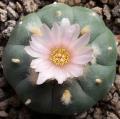DMT-Nexus member
  
Posts: 196 Joined: 15-Jan-2013 Last visit: 09-Feb-2024 Location: paradise
|
On the top being stronger than the sides claim. Notice in this paper that the opposite was reported to be true for Lw.
It is always good never to blindly trust any 'authority' and published accounts. It is much better to read what one finds and then test the claims in the real world.
|
|
|
|
|

Dreamoar

Posts: 4711 Joined: 10-Sep-2009 Last visit: 15-Dec-2025 Location: Rocky mountain high
|
I'm referring to this section: Quote:3.3.4 Mescaline content of some L. williamsii specimens
The results of this experiment were rather surprising. After the ammoniacal development of the plate, it appeared that under UV light only 3 of 10 specimens showed an observable amount of mescaline (Figure 43 left). After derivatization, these showed up as upersaturated spots (Figure 43 right). The other samples appeared to stain only very weakly n the mescaline band and even then sometimes as light brown instead of purple spots.
|
|
|
DMT-Nexus member
  
Posts: 196 Joined: 15-Jan-2013 Last visit: 09-Feb-2024 Location: paradise
|
Thanks!
Some thoughts.
Those caespitosas have been previously reported to be completely devoid of mescaline in a Japanese study by Fujita. Some of those others could be fricii , most don’t appear to be though. There are some problems precluding being able to evaluate this. 1) These are all cultivated plants so we are trusting the IDs are correct. 2) There is not a lot of detail for a decent part of the set.
Keeping plants well watered is known to have an adverse impact on alkaloid but I would still anticipate them to have more representatives with mescaline.
Sampling errors could also be involved.
My first thought is maybe something went wrong for the workers that they did not catch but I don’t have any actual answer.
This needs to be replicated by someone else and see if something similar emerges. In Molly Klein's samplings separately looking at multiple specimens there was a rather wide range of concentrations but none that were zero or dramatically weaker.
I’d love to see this done with wild plants or at least using plants with a clear provenance for the set.
At this point all I have is more questions.
|
|
|
DMT-Nexus member
  
Posts: 196 Joined: 15-Jan-2013 Last visit: 09-Feb-2024 Location: paradise
|
Below are the references that came to mind. This does not answer the question about those results but does add a bit more doubt. The most plausible thought seems to be that it might have involved either bad identifications as was true for Aragane & Sasaki or there were analytical problems. I'd love to know the flower color on the specimens that tested 0. There was trouble attaching the files so am including sci-hub links. Aragane and also Sasaki looked at something that looks like caespitosa and found mescaline. https://sci-hub.se/10.1007/s11418-010-0469-7https://sci-hub.se/10.1248/bpb.32.887They also had results more like one would expect for all of their L. williamsii outside of the specimens they had acquired as L. fricii (i.e. Ginkangyoku) and decided to rename based on Anderson’s view of the genus which considered fricii just williamsii. In one paper they refer to these as var decipiens. No actual williamsii in their work came up without mescaline. Fujita looked at what they obtained as caespitosa and did not find mescaline. Based on what they did find they appear to have been looking at diffusa or fricii. https://sci-hub.se/10.1248/yakushi1947.92.4_482Molly found mescaline in all of her samples except for the three she spilled and could not analyze. https://www.cactusconser..._Haseltonia_20_34-42.pdf
|
|
|
DMT-Nexus member
  
Posts: 196 Joined: 15-Jan-2013 Last visit: 09-Feb-2024 Location: paradise
|
I came across a paper that reminds me of this due to the numbers not seeming right and observing something unidentified in one of their samples. (µg/µL x 0.1 = %) Tthe numbers in it raised a lot of questions for me.
|
|
|

DMT-Nexus member
Posts: 545 Joined: 02-Dec-2017 Last visit: 07-Jun-2025 Location: right side of the river
|
Nothing very surprising, it is a common belief here that lophophoras growing in Europe do not contain mescaline. When I started to be interested in sacred cacti 30 years ago, this was the very first information I came across (that it is not worth the effort as there is no mescaline)
Moreover, lack of mescaline in these cacti is the main official reason why it's not ilegal to grow lophophoras in my country.
It is often stated that main factor is lack of sunshine due to northern latitude. This is probably not true, another explanation could be that due to the selection process of botanists and cactus enthusiasts, European cactus collections are full of specific phenotypes (and chemotypes), which are not very common in natural areas.
|
|
|
DMT-Nexus member
  
Posts: 196 Joined: 15-Jan-2013 Last visit: 09-Feb-2024 Location: paradise
|
Outside of genetic potential the single largest contributor appears to be watering history. Peyote in the wild typically experiences 9 or more months of drought with long periods of high heat every year. G. Gigliani Siniscalco compared williamsii cultivated in Italy looking at well watered plants vs those drought stressed for 6 months and reported a 23X difference. Another way to view that is that abundant watering caused those plants to be 23X weaker. This is the primary reason underlying why cultivated Lw is disdained by traditional peyote users.
|
|
|

DMT-Nexus member
Posts: 212 Joined: 16-Oct-2016 Last visit: 10-Feb-2025
|
Yes, although in this paper it seems the plants are coming from the same collection. This does not suggest watering differences. Also, the alkaloid profile turns out different. As if the synthetic pathway was blocked somewhere. I'm not convinced differences in soil composition aren't responsible...
|
|
|

DMT-Nexus member

Posts: 14191 Joined: 19-Feb-2008 Last visit: 22-Nov-2025 Location: Jungle
|
By the way the author's email is in the paper... I haven't tried to contact this author in particular but generally i've found that contacting researchers directly works well, they tend to respond and be happy to answer any doubts people have regarding their publication. Might be worth a try 
|
|
|
DMT-Nexus member
  
Posts: 196 Joined: 15-Jan-2013 Last visit: 09-Feb-2024 Location: paradise
|
One other consideration is that they did not appear to attempt any replicates to test and eliminate operator or procedural problems being involved. When people get divergent results, a good worker will attempt to repeat what they just did to confirm something did not go wrong.
The ability to produce consistent outcomes should always among the first things to evaluate and establish.
That did not occur with either one of these papers.
Ammonium as the nitrogen source in the soil contributes to better alkaloid production. in many plants including cacti.
|